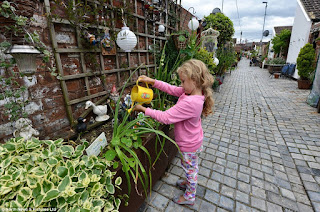Back in July, I published a blog 'Is it too late to Gate', addressing the proposal that we should consider seeking a gating order to enclose our lanes here at South Terrace.
Since then, a short discussion with John Hirdman suggests that the council may resist such a measure here on the grounds that a grant for us could open the floodgate for like applications across the town.
Following the success of Christopher Donaldson's Back Lanes of Darlington Facebook group depicting photographs of horrors and success, back lanes have become a white-hot topic. But my work with Christopher has caused me to think much more about the present day function of our back lanes, and of their future.
The idea of lanes developed from the boundaries of Burgage plots backing medieval homes. With 18th century urban development, the back lane concept was captured as a service road for tradesmen and servants, and this persisted until the 1st World War. And therein was the back lane's doom. Middle class properties turned their back on their back lanes, and this prejudice persists to this day.
With 21st century living, the idea that a back lane should be neglected is absurd. Urban space is at a premium; there are fewer safe places for children to play; and fewer community spaces for neighbours to meet. That our back lanes are left to the rule of town councils misses entirely their potential benefit as a community resource.
Thanks to Tina Mortimer for the photo
Here in Darlington, most back lanes are used simply for rubbish collection and recycling - a 'once a week' event. Because they have no other purpose, they become dumping grounds for residents and incomers. Successful projects have been run in Middlesbrough in which lanes have been gated and restored to community use - and importantly, community management. As in many urban areas, Middlesbrough supplied large communal refuse points - both freeing up space in the lanes, and reducing refuse collection costs.
So, how can we take control over our back lanes without gating orders? Contributors to the argument observe that minus the gates, community lanes may simply be wrecked.
This blogger is not so sure. Our recent experience in developing the 'Gerald Lee Pocket Park - the Smallest Park in Britain' defied that argument. Yes, the park has had occasional losses, but for a venture so close to the highway, it has survived in bloom, well enough to celebrate its first anniversary in August.
The main protection against theft and damage would be restrict the access for vehicles, save for those of residents. Because of the narrowness of the lanes and parking restrictions, many of Darlington's lanes are infrequently used for residents' cars, so some restriction is unlikely to cause significant problems.
One proposal is for the judicious use of fold-down or telescopic security posts, with keys or combination locks. A commentator with some experience suggests that these could revolutionise the use of lanes, keeping out unauthorised traffic and giving encouragement for residents to dress their lanes.
It may be that local byelaws would permit this, or alternatively a short amendment to s.129 Highways Act 1980. The latter is certainly not out of the question, as gating orders were themselves introduced this way in 2006 under s.2 Clean Neighbourhoods and Environment Act 2005.
So, do we simply say 'Its too much effort'? Or would we like to take back our back lanes? The answer is really up to you!
Thanks to North News & Pictures Ltd for the photos














